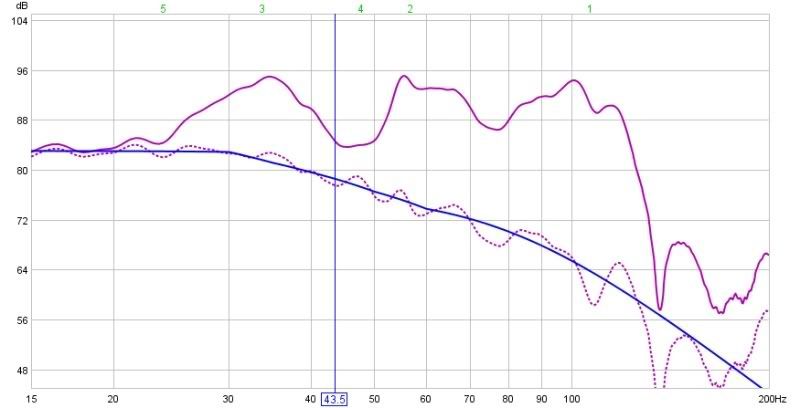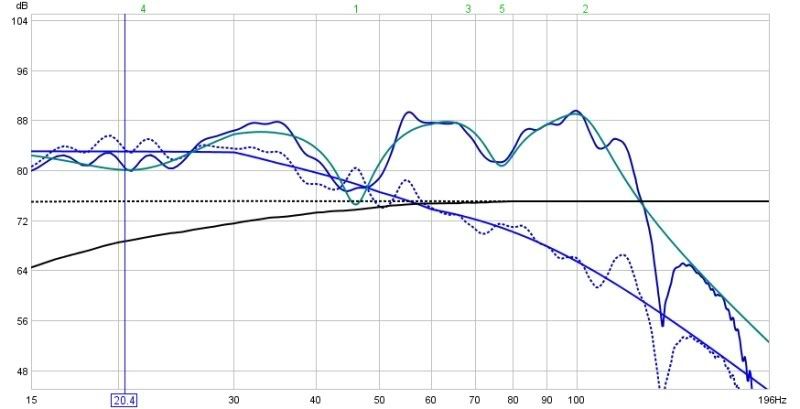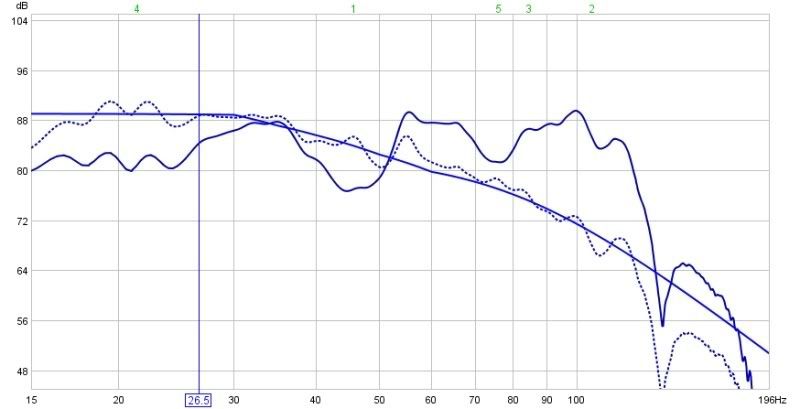|
|
Post by jagman on Mar 13, 2008 22:04:08 GMT -7
Guys... I have a dual Ascendant Audio Avalanche 18" IB centered above my HT screen. Here is a plot of my in room response at the seated position. I've included three lines... the naked response, the target level and EQed response.  In the plot, you can see I set the input level such that I needed to only cut response (so I wouldn't have to boost the lower end). As you can also see, I needed to massively cut response. The guys at the REW forum don't think it's a good idea because the level might be cut to the point that the amp isn't getting enough input (my words) and I'm using REW to essentially set the level. Clearly I'm fighting a massive amount of upper bass energy in the room. A small part this is I forgot to unhook the mains. I wish it was a major part, but when I forgot to unhook them previously, doing so only got rid of the significantly quieter ripple above 140Hz. It's really strange. Besides remeasuring with the mains pulled  , probably the best thing to do is get an external crossover to set the low pass lower than it is in the current setting. Unfortunately the integrated amp that I have has minimal flexibility (either cross over the mains to the sub at 80Hz or not at all). Have any of you had issues with excessive upper bass output? I realize this is most likely due to the natural roll off of a sealed enclosure... I'm just curious. Thanks in advance. EDIT: grammar |
|
|
|
Post by jagman on Mar 13, 2008 22:43:22 GMT -7
BTW, I've contemplated installing a second IB centered right to left in the ceiling at the back of the room. Since my current IB is centered left to right in the ceiling at the front of the room, the second IB would go along with one of the recommended locations in the the Harman white papers. If I end up doing a second IB, it will have to wait for a while. The peaks and dips in the plot above are in line with what's expected given my room dimensions (20' wide, 16' deep and 9' tall).
|
|
|
|
Post by chrisbee on Mar 14, 2008 3:41:38 GMT -7
What is the claimed Fs of your drivers? It may be high. Easily checked with a series resistor, REW sinewaves and a small audio amplifier.
I'd stop fiddling about and put some boost on at 20Hz.
Keep the boost filter as wide as possible without adding to your 35Hz peak.
Start with a clean sheet in REW and keep adding 1dB extra at 20Hz until you get more bottom end showing on "all measured".
I ran +16dB @ 20Hz 120/60 until I obtained new 16Hz drivers.
I'm still using +4dB @ 20+5Hz 35/60 with the new drivers to flatten the curve to 12Hz.
|
|
|
|
Post by chrisbee on Mar 14, 2008 3:45:48 GMT -7
A nearfield response would be useful to see what sort of room gain your are getting at the listening position.
|
|
|
|
Post by ThomasW on Mar 14, 2008 10:07:52 GMT -7
Krister,
There are 2 practical ways of dealing with the null.
1) Use much larger (deeper) bass traps.
The null is caused by reflected (indirect) 44Hz sound meeting the direct radiating 44 Hz sound. To 'fix' the null you must kill the reflected 44Hz material. Your current traps aren't nearly deep enough to absorb 44Hz sound.
2) Use the needed amount of EQ and compensate for any line level losses caused by the large amount of 'cut'.
'Theory' says uses the fewest number of filters. That's well and good if the situation permits. Unfortunately 'reality-bites' and it's often necessary to use a bunch of filters to accomplish the job.
If using a lot of 'cut' creates the situation where the drive voltage to the amp is too low, then boost it accordingly. If this means running a line level shifter after the BFD, then that's what needs to be done.
|
|
|
|
Post by carvernut on Mar 14, 2008 11:00:05 GMT -7
cool i needed to know this info as well... the fun part is going to be tracking where the sound is being reflected from and then treat it... but i'm guessing the front of the room is where mine is coming from
and you could just get a 1/3 octave EQ, run your sub line into it and then you have the option of tweaking your lower end, or just get the BFD1124, gives you 1/60 octave tweaking options for your low end
|
|
|
|
Post by jagman on Mar 14, 2008 17:47:34 GMT -7
Thanks for all the advice. The crazy thing is I have floor to ceiling traps in three of the vertical corners. They are 2' wide, 6" deep and 9' tall and solid 8# mineral wool. I also have 6" deep 3# fiberglass in the horizontal corners. The only corner without a bass trap is the front left and it has a door right at the corner. If necessary, I could open the door and get a wonderful trap  . I've also put a massive bass trap behind the seated position to quell the null from proximity to the rear wall. It is 6' wide, 4' tall, 6" deep 8# mineral wool... and it's pulled 12" from the wall. It would be pretty hard to have more bass traps than I have  . It seems to me dropping the low pass from 80Hz to 60 Hz and EQ as necessary is the only reasonable answer. BTW, the claimed Fs is 16.0 Hz. |
|
|
|
Post by ThomasW on Mar 14, 2008 19:38:21 GMT -7
Decades ago when I first installed my electrostatic panels, I had a big time problem with comb filtering effects at ~40Hz.
The solution? Kill the 40Hz rearwave.
How was that done?
Floor to ceiling tall, 1/4 round cylinder fiberglass stuffed traps, with a radius of 24"
Problem solved..
So when I say you're traps aren't deep enough, that's what I'm talking about.
|
|
|
|
Post by jagman on Mar 16, 2008 22:58:44 GMT -7
48" diameter.... damn that is huge  !!! |
|
|
|
Post by ThomasW on Mar 17, 2008 10:18:03 GMT -7
48" diameter.... damn that is huge  !!! I use a 'wedge' with a 24" radius.. Fortunately the room is long, so having the wedges in the corners behind the planars isn't a problem. If you don't/can't make very deep traps like this or use resonant membrane traps, IMO your best bet is to use all the EQ needed to establish the plot you want. Then deal the line level drive voltages IF it's really a problem. The other thing is the relatively lowish output from your Samson amp. It has roughly 1/2 the power of the driver's Pmax rating. |
|
|
|
Post by jagman on Mar 18, 2008 1:26:38 GMT -7
Thanks for the advice. I'm more or less happy with how things are going. I think I have enough power since I haven't clipped the amp. More headroom is always nice, but I do worry about bottoming the subs.
|
|
|
|
Post by jagman on Mar 18, 2008 1:41:39 GMT -7
I've tried something different to limit excursion. Brian at Rythmik (the servo sub designer) recommended putting a resistor in series with each driver to increase the Q. It's rather complicated and controversial, but the theory is it limits excursion, especially when issues come up in blockbuster movies with large amounts of unanticipated VLF output (which might also cause the amp to clip). In my case with 5.1 Ohm / 113 watt resistors wired in series with the positive lead of each sub, the Q of each sub is now 0.9 and excursion is limited to 22mm (the XMax of the Avalanche 18 drivers is 27mm). According to Bryan, it also eases the load on the amp in the 30-60 Hz range by about 75%. Bryan has a very thorough explanation here: www.hometheatershack.com/forums/diy-subwoofers-infinite-baffle/9643-increasing-q-4-ohm-resistor.htmlI'm sorry about posting a link to another forum. His explanation would be hard to repost here so I hope it's OK. The short of it is the predicted affect is very similar to the actual effect in my HT, and the limited excursion primarily affects sound signals below 11 Hz. The sound is definitely not as clean as it was before. I'm comforted by the fact that it will be much more difficult to bottom the drivers (especially if the amp clips), but at this point I'm not sure the change is SQ is worth the trade off. For movies, I don't notice the difference in SQ, but I can enjoy movies much more since that is when the risk of bottoming the drivers is greatest. The decrease in tightness of the bass is more of an issue with music. I don't want to rush to judgment, but at the same time I'm glad I did it as it didn't cost much and is a low cost alternative to a high pass filter (and it supposedly offers more protection to amp clipping). An interesting not is because it affects output above and below Fs, it also brought down the peaks that I was originally concerned with at the beginning of this thread. Here's a plot of the new response:  If you compare this to my plot towards the top of the thread, you can see the output in the teens is about 1 dB less, but the peaks in the higher bass frequencies are about 6dB less. What that plot doesn't show is the output below 11Hz drops off immensely. I'll try to post another plot that shows that tomorrow. Here's a response with the target curve bumped up to increase the level going into the Samson S700. Obviously the gain is adjusted down to mate the IB with the mains.  On a side note, I was very concerned about the resistors getting hot, but so far that hasn't been an issue at all  . Oh yeah, in my most recent plot (not posted yet) I did a much better job with the 140-200Hz range. If I could drop the crossover to the mains to 60 Hz (instead of 80 Hz), I think I'll be in pretty good shape. The only problem is that isn't possible with my integrated amp  . The Sherwood Newcastle R-972 can't get here soon enough! |
|
|
|
Post by jagman on Mar 18, 2008 16:21:43 GMT -7
Here's the latest full spectrum curve that shows what's going on with the resistor:  And here's the latest full spectrum curve that shows what's going on without the resistor:  This one doesn't have the target level raised like the previous one, but you can easily see how adding the resistors affected output above and below Fs (16 Hz). Since the first plot has the target level raised 6dB, the gain on the amp is turned down 6dB to keep the real volume on the sub the same. Therefor, when comparing the first plot to the second, you have to decrease the EQed response in the first plot 6dB. That really shows off how much the infrasonics are reduced. Please also notice that the peaks in the 55-115 range are not nearly as high in the first plot. That of course decreases the amount of cut necessary in the region. |
|
|
|
Post by ThomasW on Mar 18, 2008 19:51:32 GMT -7
I read the HTS thread a while ago. The resistor recommendation seemed like something that was interesting as a theoretical concept and probably worthless in the real world.
If you want to increase the overall output why not simply use a high-pass filter? They'll protect the drivers from over excursion at very low frequencies and allow for higher output at higher frequencies.
BTW have you solved the question of why the sub still has output at 150Hz?
|
|
|
|
Post by jagman on Mar 18, 2008 20:18:38 GMT -7
Thomas...
I think you're probably right about the resistor. But, as you know, part of science is experimenting. You never know until you try. It might have been something special had the sound not been so muddied.
Unfortunately I haven't figured out why there is so much output above 100 Hz. The plot with the raised target level is with the mains disconnected. The mains are set to small so the stereo signal crosses over to the sub at 80Hz. I double checked the setting and it was done properly.
Oh well,
Krister
|
|
|
|
Post by ThomasW on Mar 18, 2008 20:35:48 GMT -7
What is the specific (integrated amp/receiver/pre-pro/or whatever) that's filtering the signal to the sub?
|
|
|
|
Post by jagman on Mar 19, 2008 9:12:27 GMT -7
Nakamichi Ia-1z. I bought it off Ubid back in 2000. At the time it was a steal... the MSRP was $3200 and I got it for just shy of $1k. Here's a review... www.technofile.com/articles/nakamichi_amp.htmlI searched for the manual online but didn't find it. edit: mine is the version without DTS |
|
|
|
Post by ThomasW on Mar 19, 2008 9:47:51 GMT -7
No way is there an operational 80Hz crossover given the plots you've been posting. So either the unit is defective or there's some buried setting you've missed.
|
|
|
|
Post by jagman on Mar 19, 2008 13:27:37 GMT -7
I agree. I'll probably just live with the resistor or cut it out and be careful with the movies until the S/N R-972 comes out. Not only does it have the Trinnov Optimizer, which spacially relocates the speakers and adjusts in room response to multichannel audio and cinema stanards, but for the sub, it also has user adjustable high pass, low pass and phase control. And, all are set before the Trinnov Optimizer does it's work. I've heard that it initially sets the high and low pass at -6dB, but then the user can put them wherever he chooses. Should be fun to play with. Of course I'll still have the Behringer on standby  . Should be lots of fun. The only problem is the date it goes on the market keeps getting pushed back. |
|